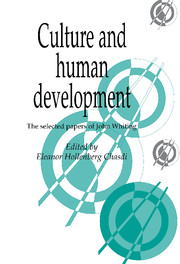Book contents
- Frontmatter
- Contents
- List of figures
- Preface
- Acknowledgments
- Introduction: John Whiting and anthropology
- Fifty years as a behavioral scientist: autobiographical notes
- Part I Theory and methods
- Part II Environment and history
- Part III Moral development
- Part IV Gender development
- Part V Development of social behavior
- Introduction
- 11 Altruistic and egoistic behavior in six cultures
- 12 The duration of maidenhood across cultures
- 13 Social change in adolescent sexual behavior, mate selection, and premarital pregnancy rates in a Kikuyu community
- Bibliography
- Complete bibliography of John W. M. Whiting's work
- Index
13 - Social change in adolescent sexual behavior, mate selection, and premarital pregnancy rates in a Kikuyu community
Published online by Cambridge University Press: 23 December 2009
- Frontmatter
- Contents
- List of figures
- Preface
- Acknowledgments
- Introduction: John Whiting and anthropology
- Fifty years as a behavioral scientist: autobiographical notes
- Part I Theory and methods
- Part II Environment and history
- Part III Moral development
- Part IV Gender development
- Part V Development of social behavior
- Introduction
- 11 Altruistic and egoistic behavior in six cultures
- 12 The duration of maidenhood across cultures
- 13 Social change in adolescent sexual behavior, mate selection, and premarital pregnancy rates in a Kikuyu community
- Bibliography
- Complete bibliography of John W. M. Whiting's work
- Index
Summary
The study of puberty rites, their meaning and function, has long been important to anthropology (Frazer 1890 [1959]; van Gennep 1909). Studies of sexuality, sex-role identity, and gender politics have also been foci of increasing interest (Broude 1981; Herdt 1982). These concerns have assumed practical relevance as rapid shifts in population growth rates and individual reproductive histories have emerged as frequent concomitants of accelerated socioeconomic change in developing countries (Nag 1980). Too frequently, human reproductive behavior has been examined outside its cultural context, and there is a growing awareness that that context must be included in order to achieve adequate dynamic models of human fertility (Caldwell 1982; World Bank 1984).
This report documents an example of interactions of cultural change with adolescent fertility and marriage patterns in an East African community. Between 1950 and 1980 the rate of unwed motherhood in Ngeca, a Kikuyu town in central highland Kenya, showed a marked increase. According to a census carried out by the Child Development Research Unit, of the 214 children born between 1940 and 1970, the percentage reported by respondents to be children of unwed mothers was 0 percent in the 1940s, 4.8 percent in the 1950s, and 11.4 percent in the 1960s. This change is statistically significant. It may be the result of reporter bias, but we and the people of Ngeca believe that there has been a real increase in unwed motherhood during this period. We will present evidence of recent changes in Kikuyu culture that may account for this change. Such an analysis will, moreover, contribute to our understanding of the functions of ritual and of the social structure of human experience.
- Type
- Chapter
- Information
- Culture and Human DevelopmentThe Selected Papers of John Whiting, pp. 306 - 323Publisher: Cambridge University PressPrint publication year: 1993



